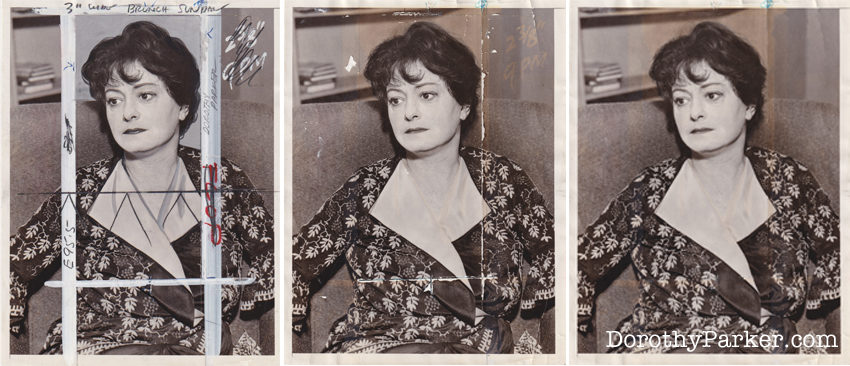
The problem was that it was covered in the markings of various newspaper editors. It looks like the photo came from a newspaper morgue. It had at least five kinds of crop marks, had been retouched to make Mrs. Parker’s lips more full, and the background was painted out. But what really bothered me were the stripes of white paint that block a large part of the image.
I knew I wanted to get the photo back to close to what it originally looked like. According to the data on Getty Images—which can’t be trusted—the photo was from January 1, 1932. If the date is to be believed, and I have no reason to doubt it, then Mrs. Parker is 38 years old. This was a big year for her, because it was when her relationship with future second husband Alan Campbell was beginning (married in 1934) and she was writing a lot of short fiction that is popular today. So I knew the photo was a valuable record from this era.
I consulted my friends on Facebook, and they asked their friends. It was a lot of back and forth, with opinions and ideas of how to do it. I thought chemicals would be the way to go. It was suggested to use ethyl alcohol, lighter fluid, and Bestine solvent and thinner (used to remove rubber cement). I ordered the Bestine, and while waiting for it to arrive, read the comments on Facebook:
Kelley wrote: “You can possibly take a small swab with ethyl alcohol to see if that will remove any of the grease pencil; however, be sure to do a small test patch before applying to the overall surface. Good luck.”
But then Nora got me really thinking if I should just leave the photo alone, and suggested hiring a conservation specialist: “Depending on the goals of the owner, this is a case of where virtual restoration w a photo editing program is useful. A professional conservator specializing in photographs could be consulted, but the marks are not accidental. They are part of the artifact’s original use and context and have meaning. Seek here by specialty and area.”
John weighed in: “Copy them and Photoshop why change the history of the object?”
So I took all of the comments, and there were about 40, to heart. The Bestine arrived and I was ready to go. Here’s the process:

PROCESS
First I cleaned the photo of dust using cotton balls. It was dirty. I scanned it. I then used a number 2 eraser to lightly remove the pencil markings. Incredibly they came right off. This was encouraging. The photo was starting to show itself. But also some of the white paint was also rubbing off, which was curious but also good to know.
I opened the Bestine. I had cotton swabs and balls, and a cloth. Using the directions from the comments, I started on one small part at the edge of the image (not Mrs. Parker’s face). It seems like as soon as I swabbed, the Bestine evaporated and the white paint stayed in place, but lightly faded a bit. I did this for about 15 minutes with no good results. Then I had an idea. Water.
I had a cup of water on the table and dipped a swab in. The paint came right off. Then it all came off. Using a cotton ball and water, I lightly applied water in steaks from top to bottom. All the white paint and grease pencil residue came right off. I used more water to remove the remainder of the paint. A few pieces of the image, small flecks, were lifted off where the paint had pooled. But I could finally see the entire image without any markings. However, it was left with deep gouges from where the editor’s pencils and rulers had come down hard on the image itself. It was lined with a thin line of no gelatin left, and pieces flaked off.
I let the image dry overnight; it was staring to curl up. I put it between two books to dry. The next day I scanned it again, to show it with the markings removed.
I have fairly meager Photoshop skills, but I took a crack at it. I wanted to get rid of the white patches, flakes, and lines left by removing the paint.
I am not 100% satisfied with how it looks now, but I am happy to add another Dorothy Parker photo to my collection. There are really only around 30-40 photos of her that are useable for seeing what she looked like. And of that, there are less than 10 that are decent portraits. So to reclaim an image of her before WWII is nice to have. What I’ll do next with the image I do not know.
Thanks to all who offered me their suggestions on the hive mind of Facebook.
If you want to know more about Dorothy Parker, you could pick up my book A Journey Into Dorothy Parker’s New York, which has many of my rare images of her included.

